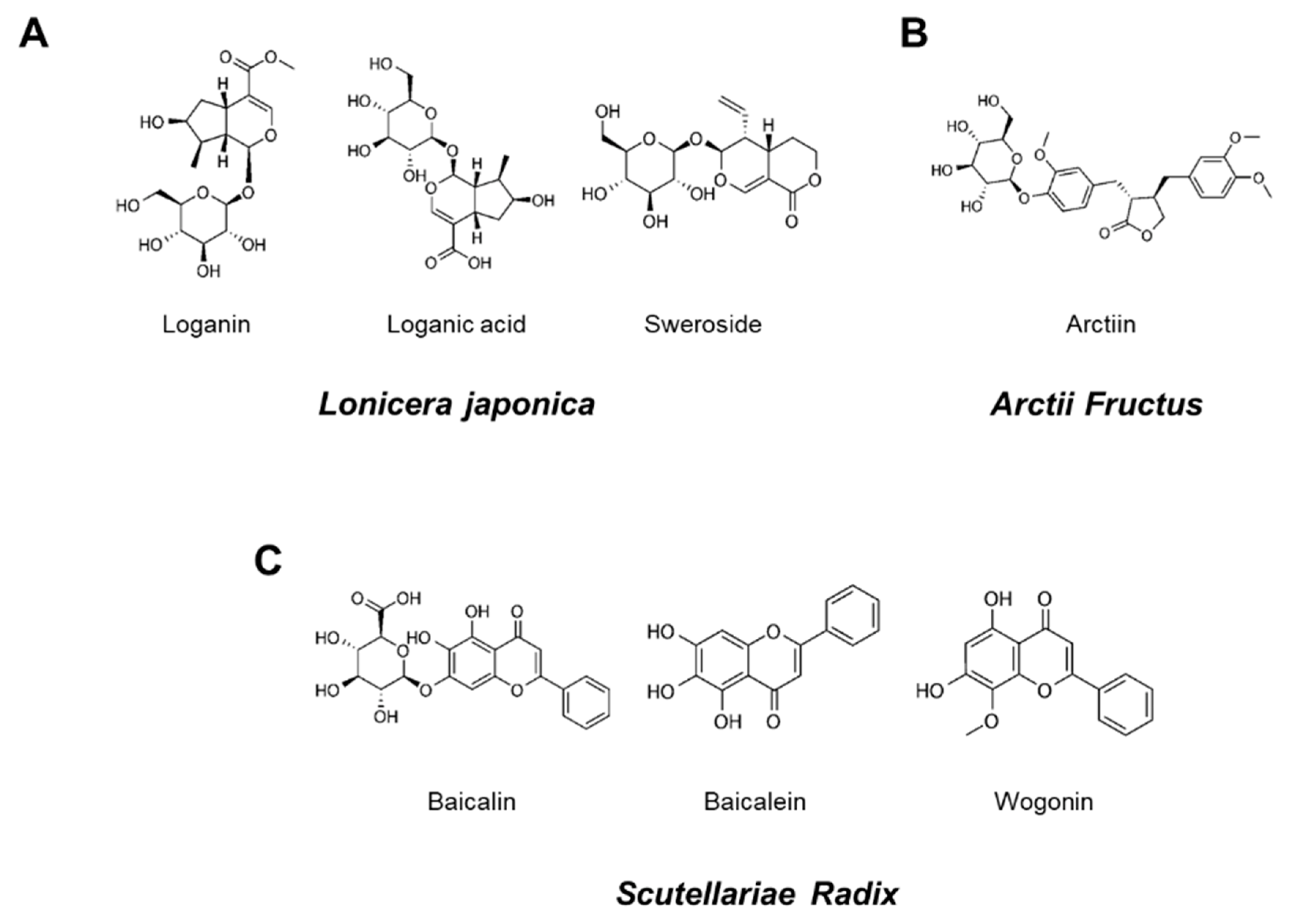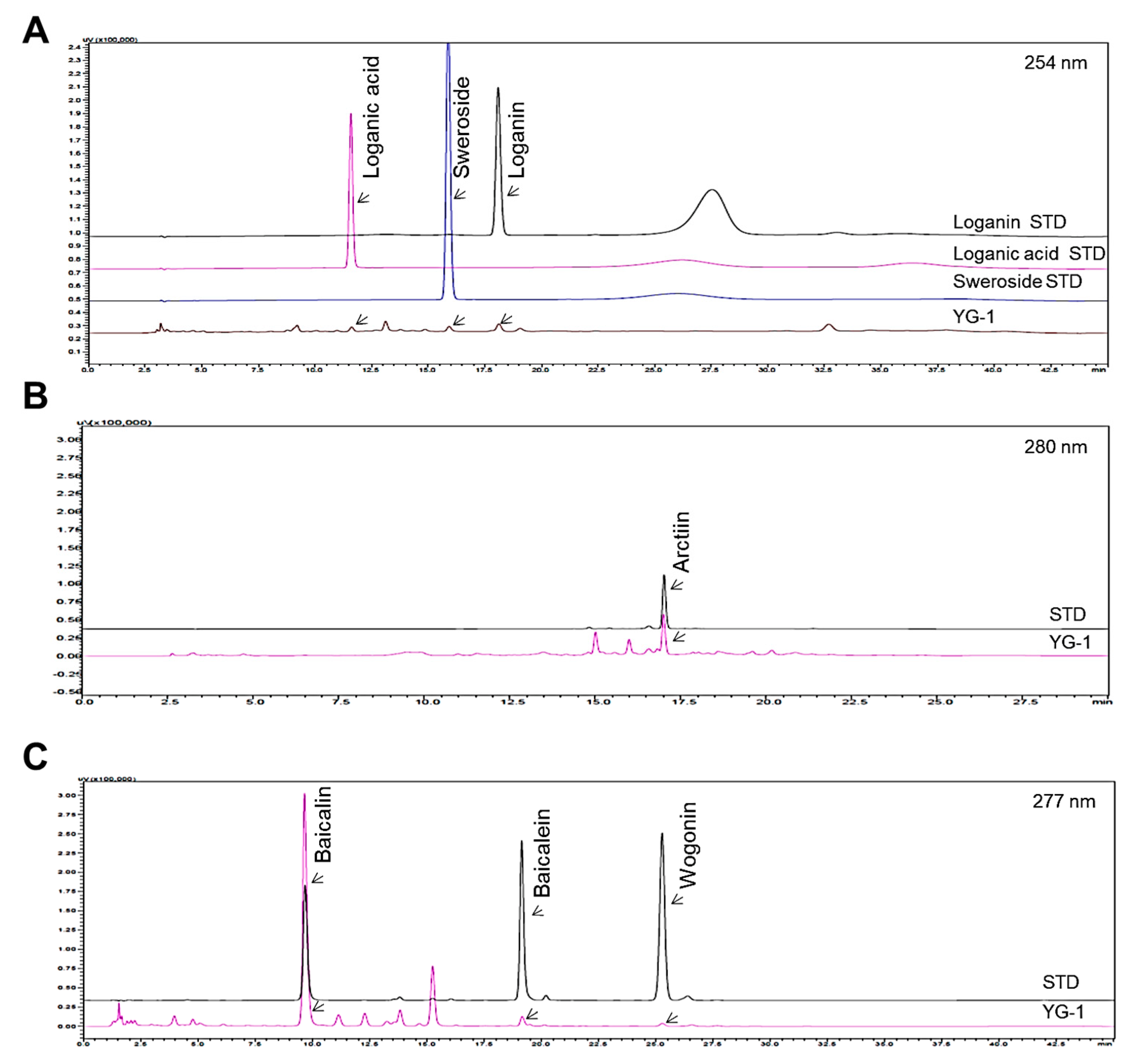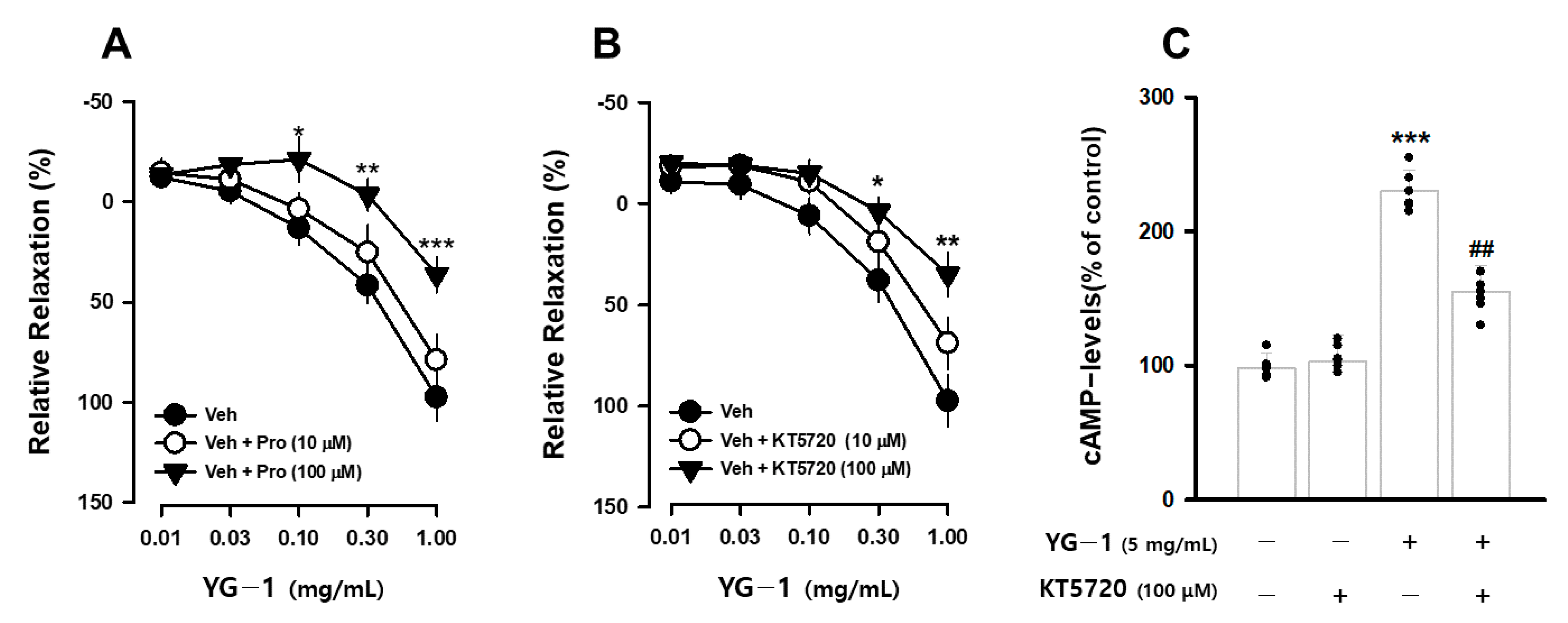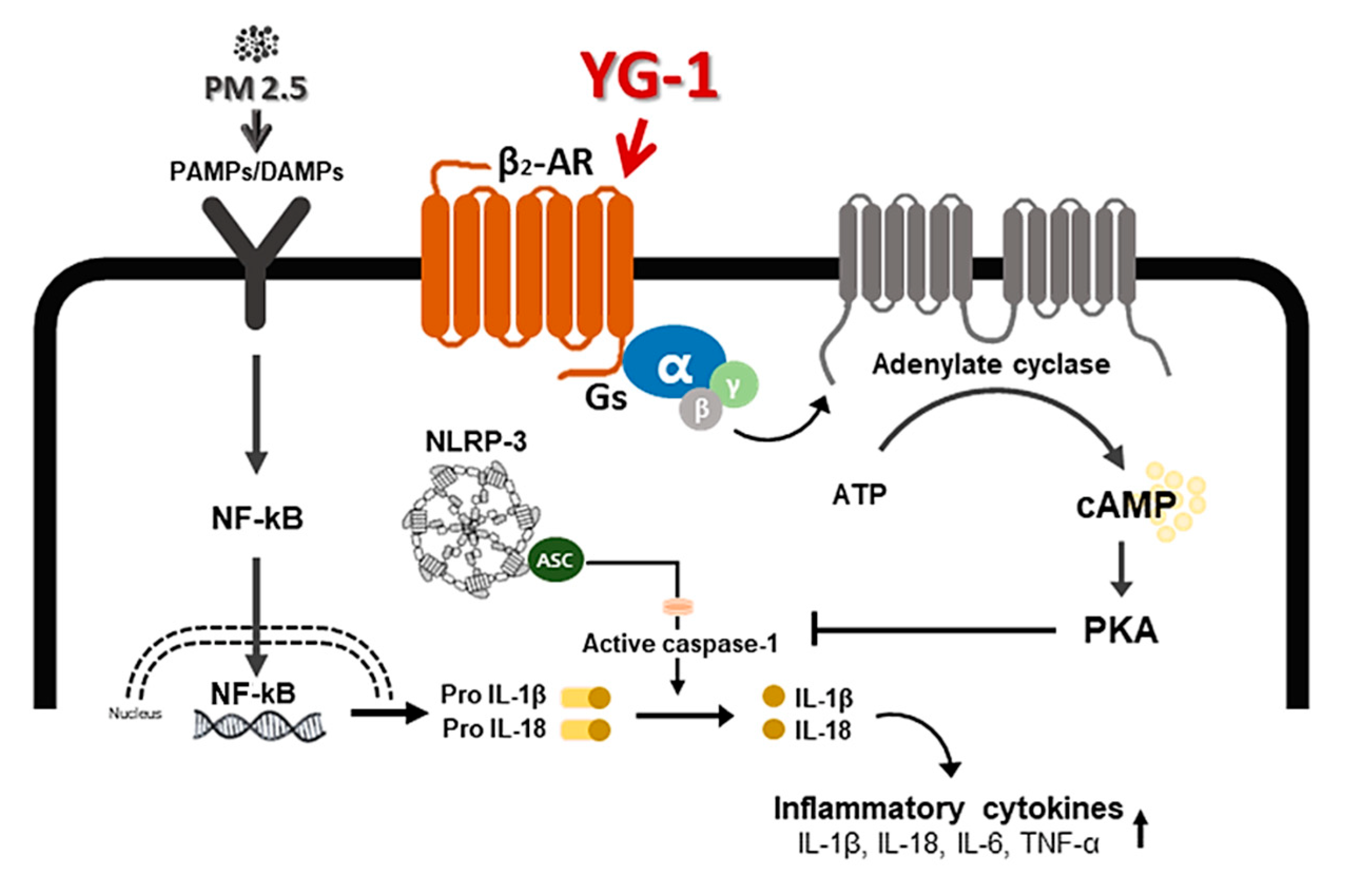YG-1 Extract Improves Acute Pulmonary Inflammation by Inducing Bronchodilation and Inhibiting Inflammatory Cytokines
Abstract
:1. Introduction
2. Materials & Methods
2.1. Preparation of YG-1 Extract
2.2. HPLC Analysis of YG-1
2.3. Isolation of Bronchial Tissue and Measurement of Bronchodilation (Ex Vivo)
2.4. Measurement of cAMP Levels in Bronchial Tissues
2.5. PM2.5-Induced Acute Lung and Bronchial Inflammation Mouse Model
2.6. Histological Analysis
2.7. Western Blot Analysis and Antibodies
2.8. Quantitative Real-Time Reverse Transcription-PCR of Lung and Bronchial Tissues
The Real-Time qRT-PCR of Lung and Bronchial Tissues
2.9. Statistical Analyses
3. Results
3.1. HPLC Chromatograms of Compounds from YG-1 Extract
3.2. Concentration-Dependent Bronchodilation Effect of YG-1 Extract in Bronchial Smooth Muscle
3.3. Effects of YG-1 Extract on Improving the β2-Adrenergic Receptor/PKA Pathway in Bronchial Smooth Muscle
3.4. Effect of YG-1 on Reducing Bronchial and Lung Fibrosis in PM2.5-Exposed Airway Inflammation Mice
3.5. Effect of YG-1 on Reducing Bronchial and Lung Inflammation in PM2.5-Exposed Airway Inflammation Mice
4. Discussion
5. Conclusions
Author Contributions
Funding
Institutional Review Board Statement
Informed Consent Statement
Data Availability Statement
Acknowledgments
Conflicts of Interest
References
- Matera, M.G.; Page, L.; Calzetta, P.; Cazzola, M. Pharmacology and therapeutics of bronchodilators revisited. Pharmacol. Rev. 2020, 72, 218–252. [Google Scholar] [CrossRef] [PubMed]
- Cazzola, M.; Page, C.P.; Calzetta, L.; Matera, M.G. Pharmacology and therapeutics of bronchodilators. Pharmacol. Rev. 2012, 64, 450–504. [Google Scholar] [CrossRef] [PubMed]
- An, S.S.; Fredberg, J.J. Biophysical basis for airway hyperresponsiveness. Can. J. Physiol. Pharmacol. 2007, 85, 700–714. [Google Scholar] [CrossRef] [PubMed] [Green Version]
- Xing, Y.F.; Xu, Y.H.; Shi, M.H.; Lian, Y.X. The impact of PM2.5 on the human respiratory system. J. Thorac. Dis. 2016, 8, E69–E74. [Google Scholar] [PubMed]
- Kim, H.H. Allergic rhinitis, sinusitis and asthma—Evidence for respiratory system integration. Korean J. Pediatr. 2007, 50, 335–339. [Google Scholar] [CrossRef]
- Shin, D.C. Health effects of ambient particulate matter. J. Korean Med. Assoc. 2007, 50, 175–182. [Google Scholar] [CrossRef]
- Kim, D.S.; Bae, G.; Kim, S.K.; LEE, H.S.; Kim, Y.J.; Lee, S.H. Retrospective drug utilization review of antibiotics for respiratory tract infection(RTI) in ambulatory outpatient care. Korean J. Clin. Pharm. 2012, 22, 291–303. [Google Scholar]
- Atkinson, R.W.; Carey, I.M.; Kent, A.J.; Van Staa, T.P.; Anderson, H.R.; Cook, D.G. Long-term exposure to outdoor air pollution and the incidence of chronic obstructive pulmonary disease in a national English cohort. Occup. Environ. Med. 2015, 72, 42–48. [Google Scholar] [CrossRef] [Green Version]
- Zhao, B.; Zheng, H.; Wang, S. Change in household fuels dominates the decrease in PM2.5 exposure and premature mortality in China in 2005. Proc. Natl. Acad. Sci. USA 2018, 115, 12401–12406. [Google Scholar] [CrossRef] [Green Version]
- Schultz, E.S.; Litonjua, A.A.; Melen, E. Effects of long-term exposure to traffic-related air pollution on lung function in children. Curr. Allergy Asthma Rep. 2017, 17, 41. [Google Scholar] [CrossRef] [Green Version]
- Huang, W.; Wang, G.; Lu, S.E. Inflammatory and oxidative stress responses of healthy young adults to changes in air quality during the Beijing olympics. Am. J. Respir. Crit. Care Med. 2012, 186, 1150–1159. [Google Scholar] [CrossRef] [Green Version]
- Ogino, K. Allergic airway infammation by nasal inoculation of particulate matter (PM2.5) in nc/nga mice. PLoS ONE 2014, 9, e92710. [Google Scholar] [CrossRef] [Green Version]
- Wang, H. The acute airway infammation induced bypm2.5 exposure and the treatment of essential oils in balb/c mice. Sci. Rep. 2017, 7, 44256. [Google Scholar] [CrossRef]
- Mahemuti, G.; Zhang, H.; Li, J.; Tieliwaerdi, N.; Ren, L. Efficacy and side effects of intravenous theophylline in acute asthma: A systematic review and meta-analysis. Drug Des. Devel. Ther. 2018, 12, 99–120. [Google Scholar] [CrossRef] [Green Version]
- Huang, J.; Pansare, M. New treatments for asthma. Pediatr. Clin. N. Am. 2019, 66, 925–939. [Google Scholar] [CrossRef]
- Mushtaq, S.; Abbasi, B.H.; Uzair, B.; Abbasi, R. Natural products as reservoirs of novel therapeutic agents. EXCLIJ 2018, 4, 420–451. [Google Scholar]
- Lee, Y.C.; Kwon, T.H.; Ok, I.S.; Seo, C.W.; Kim, Y.J.; Roh, S.S.; Seo, Y.B. The experimental studies on the immunomodulational effects of Lonicerae Caulis et Folium: The effects of Lonicerae Caulis et Folium on cytokines production in mice splenocytes. Korea J. Herbol. 2005, 20, 141–149. [Google Scholar]
- Nam, J.Y.; Kim, D.G.; Lee, J.Y. Effects of Woobangja on anti-allergic inflammation. J. Pediatrics Korean Med. 2006, 20, 241–255. [Google Scholar]
- Cho, S.H.; Kim, Y.R. Antimicrobial characteristics of Scutellariae Radix extract. J. Korean Soc. Food Sci. Nutr. 2001, 30, 964–968. [Google Scholar]
- Song, I.B.; Na, J.Y.; Song, K.B.; Kim, S.H.; Lee, J.H.; Kwon, Y.B.; Kim, D.K.; Kim, D.S.; Jo, H.K.; Kwon, J.K. Effects of extract mixture (Yg-1) of anti-inflammatory herbs on LPS-induced acute inflammation in macrophages and rats. J. Korean Soc. Food Sci. Nutr. 2015, 44, 49–505. [Google Scholar] [CrossRef] [Green Version]
- Wu, H.; Yang, S.; Wu, X.; Zhao, J.; Zhao, J.; Ning, Q.; Xu, Y.; Xie, J. Interleukin-33/ST2 signaling promotes production of interleukin-6 and interleukin-8 in systemic inflammation in cigarette smoke-induced chronic obstructive pulmonary disease mice. Biochem. Biophys. Res. Commun. 2014, 450, 110–116. [Google Scholar] [CrossRef]
- Sun, Q.; Yue, P.; Deiuliis, J.A.; Lumeng, C.N.; Kampfrath, T.; Mikolaj, M.B.; Cai, Y.; Ostrowski, M.C.; Lu, B.; Parthasarathy, S. Ambient air pollution exaggerates adipose inflammation and insulin resistance in a mouse model of diet-induced obesity. Circulation 2009, 119, 538–546. [Google Scholar] [CrossRef] [PubMed] [Green Version]
- Lee, M.K.; Lim, K.H.; Millns, P.; Mohankumar, S.K.; Ng, S.T.; Tan, C.S. Bronchodilator effects of Lignosus rhinocerotis extract on rat isolated airways is linked to the blockage of calcium entry. Phytomedicine 2018, 42, 172–179. [Google Scholar] [CrossRef] [PubMed]
- Sozzani, S.; Agwu, D.E.; McCall, C.E.; O’Flaherty, J.T.; Schmitt, J.D.; Kent, J.D.; McPhail, L.C. Propranolol, a phosphatidate phosphohydrolase inhibitor, also inhibits protein kinase C. J. Biol. Chem. 1992, 267, 20481–20488. [Google Scholar] [CrossRef]
- Global Initiative for Asthma. Global Strategy for Asthma Management and Prevention National Institute of Health 2002; NIH: Bethesda, MD, USA, 2002; No. 02-3659.
- Yang, C.M.; Hsu, M.C.; Tsao, H.L.; Chiu, C.T.; Ong, R.; Hsieh, J.T.; Fan, L.W. Effect of cAMP elevating agents on carbachol-induced phosphoinositide hydrolysis and calcium mobilization in cultured canine tracheal smooth muscle cells. Cell Calcium. 1996, 19, 243–254. [Google Scholar] [CrossRef]
- Hoiting, B.H.; Meurs, H.; Schuiling, M.; Kuipers, R.; Elzinga, C.R.; Zaagsma, J. Modulation of agonist-induced phosphoinositide metabolism, Ca2+ signalling and contraction of airway smooth muscle by cyclic AMP-dependent mechanisms. Br. J. Pharmacol. 1996, 117, 419–426. [Google Scholar] [CrossRef] [Green Version]
- McGrogan, I.; Lu, S.; Hipworth, S.; Sormaz, L.; Eng, R.; Preocanin, D.; Daniel, E.E. Mechanisms of cyclic nucleotide-induced relaxation in canine tracheal smooth muscle. Am. J. Physiol. 1995, 268, L407–L413. [Google Scholar] [CrossRef]
- Gao, Y.; Lv, J.; Lin, Y.; Li, X.; Wang, L.; Yin, Y.; Liu, Y. Effects of beta-adrenoceptor subtypes on cardiac function in myocardial infarction rats exposed to fine particulate matter (PM 2.5). Biomed. Res. Int. 2014, 2014, 308295. [Google Scholar] [CrossRef]
- Nel, A. Air pollution-related illness: Effects of particles. Science 2005, 308, 804–806. [Google Scholar] [CrossRef]
- Kyung, S.Y.; Jeong, S.H. Particulate-matter related respiratory diseases. Tuberc. Respir. Dis. 2020, 83, 116–121. [Google Scholar] [CrossRef]
- Aghasafari, P.; George, U.; Pidaparti, R. A review of inflammatory mechanism in airway diseases. Inflamm. Res. 2019, 68, 59–74. [Google Scholar] [CrossRef]
- Bonini, M.; Usmani, O.S. The role of the small airways in the pathophysiology of asthma and chronic obstructive pulmonary disease. Ther. Adv. Respir. Dis. 2015, 9, 281–293. [Google Scholar] [CrossRef]
- Coker, R.K.; Laurent, G.J.; Shahzeidi, S.; Hernandez-Rodriguez, N.A.; Pantelidis, P.; Du Bois, R.M.; Jeffery, P.K.; McAnulty, R.J. Diverse cellular TGF-beta 1and TGF-beta 3 gene expression in normal human and murine lung. Eur. Respir. J. 1996, 9, 2501–2507. [Google Scholar] [CrossRef] [Green Version]
- Fukatsu, H.; Koide, N.; Tada-Oikawa, S. NF-κB inhibitor DHMEQ inhibits titanium dioxide nanoparticle-induced interleukin-1β production: Inhibition of the PM2.5-induced inflammation model. Mol. Med. Rep. 2018, 18, 5279–5285. [Google Scholar] [CrossRef] [Green Version]
- Xu, F.; Qiu, X.; Hu, X. Effects on IL-1β signaling activation induced by water and organic extracts of fine particulate matter (PM(2.5)) in vitro. Environ. Pollut. 2018, 237, 592–600. [Google Scholar] [CrossRef]
- Feng, S.; Gao, D.; Liao, F.; Zhou, F.; Wang, X. The health effects of ambient PM2.5 and potential mechanisms. Ecotoxicol. Environ. Saf. 2016, 128, 67–74. [Google Scholar] [CrossRef]
- Zheng, X.Y.; Tong, L.; Shen, D. Airborne bacteria enriched PM2.5 enhances the inflammation in an allergic adolescent mouse model induced by ovalbumin. Inflammation 2020, 43, 32–43. [Google Scholar] [CrossRef]
- Li, C.; Chen, J.; Yuan, W.; Zhang, W.; Chen, H.; Tan, H. Preventive effect of ursolic acid derivative on particulate matter 2.5-induced chronic obstructive pulmonary disease involves suppression of lung inflammation. IUBMB Life 2020, 72, 632–640. [Google Scholar] [CrossRef]
- Zhu, Y.; Zhu, C.; Yang, H.; Deng, J.; Fan, D. Protective effect of ginsenoside Rg5 against kidney injury via inhibition of NLRP3 inflammasome activation and the MAPK signaling pathway in high-fat diet/streptozotocin-induced diabetic mice. Pharmacol. Res. 2020, 155, 104746. [Google Scholar] [CrossRef]
- Zhou, Y.; Zhang, C.Y.; Duan, J.X. Vasoactive intestinal peptide suppresses the NLRP3 inflammasome activation in lipopolysaccharideinduced acute lung injury mice and macrophages. Biomed. Pharmacother. 2020, 121, 109596. [Google Scholar] [CrossRef]
- Provoost, S.; Maes, T.; Pauwels, N.S. NLRP3/caspase-1-independent IL-1beta production mediates diesel exhaust particle-induced pulmonary inflammation. J. Immunol. 2011, 187, 3331–3337. [Google Scholar] [CrossRef] [PubMed]
- Chen, H.; Ding, Y.; Chen, W.; Feng, Y.; Shi, G. Glibenclamide alleviates inflammation in oleic acid model of acute lung injury through NLRP3 inflammasome signaling pathway. Drug Des. Devel. Ther. 2019, 13, 1545–1554. [Google Scholar] [CrossRef] [PubMed] [Green Version]
- Zheng, R.; Tao, L.; Jian, H. NLRP3 inflammasome activation and lung fibrosis caused by airborne fine particulate matter. Ecotoxicol. Environ. Saf. 2018, 163, 612–619. [Google Scholar] [CrossRef] [PubMed]
- Postma, D.S.; Timens, W. Remodeling in asthma and chronic obstructive pulmonary disease. Proc. Am. Thorac. Soc. 2006, 3, 434–439. [Google Scholar] [CrossRef]
- Lucas, K.; Maes, M. Role of the toll like receptor (TLR) radical cycle in chronic inflammation: Possible treatments targeting the TLR4 pathway. Mol. Neurobiol. 2013, 48, 190–204. [Google Scholar] [CrossRef]
- Kingston, H.G.; Dungan, M.L.; Sarah, A.; Jones, A.; Harris, J. The role of inflammasome-derived IL-1 in driving IL-17 responses. J. Leukoc. Biol. 2013, 93, 489–497. [Google Scholar]
- Kong, F. Curcumin represses NLRP3 inflammasome activation via TLR4/MyD88/NF-κB and P2X7R Signaling in PMA induced macrophages. Front. Pharmacol. 2016, 7, 00369. [Google Scholar] [CrossRef] [Green Version]









| Code | Scientific Name of Source | Ratio | Mixing Ratio |
|---|---|---|---|
| A | Lonicera japonica, Arctii Fructus | 3 1 | 2 |
| B | Scutellariae Radix | 2.25 | 3 |
Publisher’s Note: MDPI stays neutral with regard to jurisdictional claims in published maps and institutional affiliations. |
© 2021 by the authors. Licensee MDPI, Basel, Switzerland. This article is an open access article distributed under the terms and conditions of the Creative Commons Attribution (CC BY) license (https://creativecommons.org/licenses/by/4.0/).
Share and Cite
Kim, H.-Y.; Yoon, J.-J.; Kim, D.-S.; Kang, D.-G.; Lee, H.-S. YG-1 Extract Improves Acute Pulmonary Inflammation by Inducing Bronchodilation and Inhibiting Inflammatory Cytokines. Nutrients 2021, 13, 3414. https://doi.org/10.3390/nu13103414
Kim H-Y, Yoon J-J, Kim D-S, Kang D-G, Lee H-S. YG-1 Extract Improves Acute Pulmonary Inflammation by Inducing Bronchodilation and Inhibiting Inflammatory Cytokines. Nutrients. 2021; 13(10):3414. https://doi.org/10.3390/nu13103414
Chicago/Turabian StyleKim, Hye-Yoom, Jung-Joo Yoon, Dae-Sung Kim, Dae-Gill Kang, and Ho-Sub Lee. 2021. "YG-1 Extract Improves Acute Pulmonary Inflammation by Inducing Bronchodilation and Inhibiting Inflammatory Cytokines" Nutrients 13, no. 10: 3414. https://doi.org/10.3390/nu13103414
APA StyleKim, H.-Y., Yoon, J.-J., Kim, D.-S., Kang, D.-G., & Lee, H.-S. (2021). YG-1 Extract Improves Acute Pulmonary Inflammation by Inducing Bronchodilation and Inhibiting Inflammatory Cytokines. Nutrients, 13(10), 3414. https://doi.org/10.3390/nu13103414






